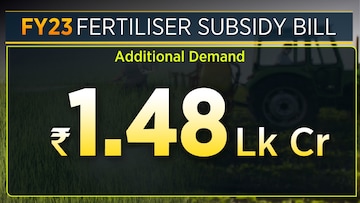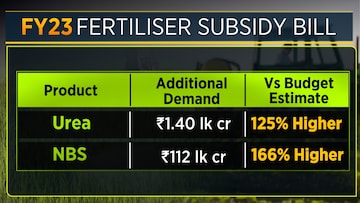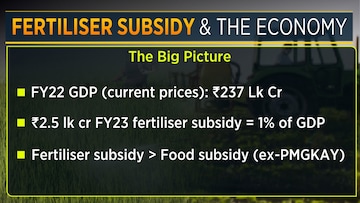
By Sapna Das Nov 11, 2022 2:58:53 PM IST (Updated)
Listen to the Article(6 Minutes)

A ballooning fertiliser subsidy bill is posing fresh fiscal challenges for the government. By the end of this fiscal, the subsidy amount is estimated to grow over three times from Rs 74,000 crore in FY19. With no quick fix available, the government is now betting on lower fertiliser and gas prices next year to help bring those numbers down.
The fertiliser subsidy bill is a crucial component of the government’s expenses every year and the trend over the last few years has been a bit worrying for a government that is keen on sticking to a fiscal glide path.
During the last three financial years alone, fertiliser subsidy has been clocking a new high every year. From a modest Rs 73,000 crore in 2019, the number jumped nearly 55 percent in two years to Rs 1.33 lakh crore in 2021 and then to a record Rs 1.62 lakh crore last fiscal. For FY23, this number is expected to come in anywhere between Rs 2.25 lakh crore and Rs 2.5 lakh crore.

This is based on the fact that the Department of Fertiliser has asked the Finance Ministry for an additional Rs 1.48 lakh crore, which will mean that the budget nearly doubles from its original size.

Of this enhanced budget, Rs 1.4 lakh crore is broadly earmarked for urea – that’s 125 percent higher than the budget estimate. The nutrient-based subsidy is pegged at Rs 112 lakh crore, which is 166 percent higher than the original budget outlay.

A Rs 2.5 lakh crore, the fertiliser subsidy bill is huge for an economy of India’s size. Even at an expanded nominal gross domestic product (GDP) of Rs 237 lakh crore, this works out to 1 percent of GDP. It’s also a little higher than the food subsidy budget of Rs 2 lakh core for FY23, if the additional financial burden brought on by the government’s free food and grains scheme – the PMGKAY – is not counted.

But the government is hopeful that the shock of a higher subsidy bill will not spill over into the next fiscal. According to government officials, as a ripple effects of global lockdowns and the Russia-Ukraine conflict fade away, next year’s fertiliser subsidy bill is likely to be lower, helped along by lower input costs and softening gas prices.

In the meantime, the government is caught between a rock and a hard place – because it has said it remains committed to protecting farmers, and fertiliser subsidies are key to that. On the other hand, it also wants to maintain its fiscal glide path. The only silver lining is that when it comes to fiscal deficit, the government can deviate from its target if extraneous circumstances beyond its control continue to play out.
For more, watch the accompanying video


| Currency | Price | Change | %Change |
|---|